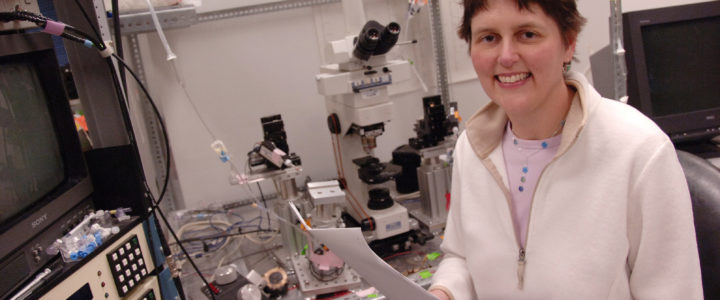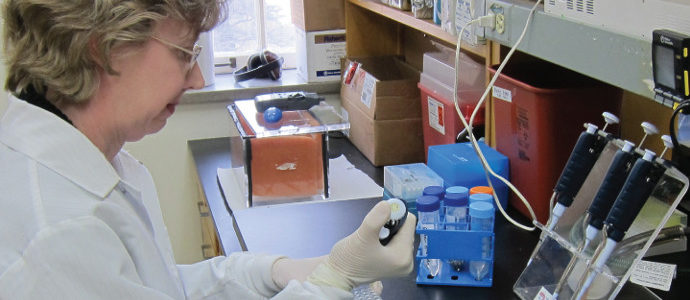New Zealand-based biotech Neuren Pharmaceuticals has announced impressive preclinical results in the Fragile X mouse model with Trofinetide. These compounds are examples of a new class of drugs based on insulin-like growth factors (IGF-1). IGF analogs are currently considered the most promising approach for treating Rett Syndrome, a fatal genetic disorder that affects only girls, and one of the other leading genetic models for the study of autism (along with Fragile X). The surprising news is that FRAXA researchers have found that this treatment strategy works even better in Fragile X knockout mice than in Rett syndrome mice! FRAXA’s strategy is to find and target the critical bottlenecks which block the way to development of treatments.
Read moreAuthor: FRAXA Research Foundation
Makenzie Cote’s Page

Makenzie is our lovely angel. Life is surely challenging for her and for us as parents raising a child with special needs. She has some developmental delays with a high level of anxiety. She loves going to school every day and she plays many sports like her peers in a league for children with disabilities. We are truly hoping for a cure to increase her quality of life like all the children deserve on this earth. We want her to be happy and proud of herself as much that we are of her. In 2008, our family in Canada started a fundraiser to raise money for the Fragile X research. They started making all kind of crafts and selling them. All the profits are sent to FRAXA in honor of our daughter who was diagnosed at 16 months old with Fragile X syndrome.
Read moreLovastatin Discovery in Fragile X Mice Leads FRAXA to Fund Clinical Trials

Dr. Emily Osterweil was awarded the FRAXA Pioneer Award at the opening dinner of the 2011 FRAXA Investigators Meeting in Southbridge, MA for her work demonstrating that Lovastatin could treat Fragile X. Dr. Osterweil conducted her experiments in the MIT laboratory of Dr. Mark Bear and has since established her own laboratory at the University of Edinburgh. The team discovered that lovastatin, a drug widely prescribed for high cholesterol, can correct excess hippocampal protein synthesis in the mouse model of FXS and can prevent epileptogenesis. The work is published in the prestigious neuroscience journal Neuron: Lovastatin Corrects Excess Protein Synthesis and Prevents Epileptogenesis in a Mouse Model of Fragile X Syndrome.
Read moreEffects of minocycline on vocal production and auditory processing in a mouse model of Fragile X

With $135,000 in grants from FRAXA Research Foundation over several years, Dr. Khaleel Razak and Dr. Iryna Ethell explored robust biomarkers relevant to the FXS and the efficacy of minocycline treatment.
Read moreEndocannabinoid Mediated Synaptic Plasticity in Fragile X Mice

With a $90,000 grant from FRAXA Research Foundation over two years, Drs. Olivier Manzoni and Daniela Neuhofer researched the relationship between Fragile X syndrome and the areas of the brain that are involved in reward processing, regulation of emotional behavior and emotional memory as well as attention, planning and working memory.
Read moreTreatment of Fragile X Syndrome via Dopamine Enhancers and Glutamate Inhibitors

FRAXA Awards $50,000 in 2011 and $50,000 in 2010 to Patricia Cogram, PhD for treatment of Fragile X syndrome via Dopamine Enhancers and Glutamate Inhibitors. This project aims to follow up our and others observations that the dopamine receptor is under expressed in the Fragile X syndrome and thus determine the effectiveness of targeted pharmacological treatments in Fragile X syndrome.
Read morePhase 2b Clinical Trial of Arbaclofen in Autism Has Disappointing Results
Phase 2b clinical trial of Arbaclofen in Autism Seaside Therapeutics reports the study did not show improvement on the primary endpoint of social withdrawal, but it did demonstrate improvement on the Clinical Global Impression of Severity scale.
Read moreDeveloping IPS cells to Screen Drugs which can Reactivate the FMR1 Gene

With $146,000 grant from FRAXA Research Foundation over 2012-2013, Drs. Anita Bhattacharyya and Xinyu Zhao at the University of Wisconsin developed a new mouse model of Fragile X syndrome which will enable testing of gene reactivation and gene therapy approaches to treatment. They transplanted human Fragile X neural cells differentiated from induced pluripotent stem cells into brains of neonatal mice and then testing for FMR1 reactivation. In 2015, The John Merck Fund assumed support for this work with a generous grant of $750,000 to the scientists. Results published.
Read moreTargeting mGluR-LTD to Treat Fragile X Syndrome

With grants from FRAXA Research Foundation from 2000-2010, Dr. Kimberly Huber and her team at the University of Texas conducted several studies on the relationship between mGluR5 and Fragile X syndrome. Dr. Huber made the original discovery of the mGluR Theory of Fragile X when she was a postdoctoral fellow in the lab of Dr. Mark Bear, with her first FRAXA grant in 2000.
Read morePreclinical Evaluation of Serotonin Receptor Agonists as Novel Pharmacological Tools in Fragile X Syndrome

With a $66,000 grant from FRAXA Research Foundation in 2013, Dr. Lucia Ciranna and her team from the Universita di Catania tested if specific serotonins could reverse abnormal phentotypes found in Fragile X syndrome.
Read moreSmall Rho GTPases, a Potential Therapeutic Target for Fragile X Syndrome

With $384,345 in grants from FRAXA Research Foundation, Dr. MariVi Tejada from the University of Houston focused on a particularly promising point of intervention in pathways of brain receptors, and tested several potential therapeutic compounds in an attempt to rescue function in the mouse model of Fragile X.
Read moreEvaluation of CamKII Dependent Regulation of mGluR5-Homer Scaffolds as a Potential Therapeutic for Fragile X Syndrome

With a $90,000 grant from FRAXA Research Foundation, Dr. Kimberly Huber and Dr. Weirui Guo at the University of Texas at Southwestern investigated the roles of Homer and CaMKII in Fragile X syndrome.
Read moreClinical Trials FAQ ← Frequently Asked Questions
Question: How Do Families Decide Which Trial is Best for Them? Answer: Each of the trials has different requirements for joining, so many – if not most – people will only be eligible for one trial after screening. The best way to approach this is to call the clinic contact closest to your area and discuss this with him/her. Age, weight, current medications, behavior, and IQ are all factors.
Read moreDarren’s Smile
Darren’s Smile – This is a very difficult post to write because it is about a son, Darren, who has passed away. Darren’s dad has written a memoir – a beautiful tribute to his son. Darren had Fragile X syndrome. He lived a rich life and was very much loved. Sadly he died because of a choking incident at the group home where he lived. There’s not much written about the risk of choking for people who have Fragile X, but I do wonder if it is a particular risk that we should remember.
Read moreNPR, “Progress Made On Drug For Autism Symptoms”

An experimental drug that helps people who have Fragile X syndrome is raising hopes of a treatment for autism. The drug, called arbaclofen, made people with Fragile X syndrome less likely to avoid social interactions, according to a newly published study. Researchers suspect it might do the same for people with autism.
Read moreA Developmental Switch Exists in the Effects of FMRP

With a $90,00 grant from FRAXA Research Foundation for 2010-2011, Dr. Kimberly Huber and her team at the University of Texas at Southwestern found that there is a developmental switch of postsynaptic FMRP on synaptic function. This switch is controlled by MEF2 transcriptional activity. Proper synapse maturation and elimination is crucial for the establishment of appropriate neural circuits that underlie sensory processing and cognition. Neuron of Fragile X patients as well as in the mouse model of Fragile X, Fmr1 KO mice, display more dendritic spines, the point of contact for excitatory synapses, as well as long and thin filopodia resembling immature spines. This suggests Fragile X mental retardation protein (FMRP) has a role in promoting synapse maturation and elimination.
Read moreAb-Mediated Translation in Fragile X Syndrome

With a $120,000 grant from FRAXA Research Foundation during 2011-2012, Dr. Cara Westmark at the University of Wisconsin explored the role of AbPP as a potential treatment option for fragile X. AbPP produces b-amyloid which is over-expressed in Alzheimer’s disease (AD) and Down syndrome.
Read moreSynaptic Actin Signaling Pathways in Fragile X

With a $163,356 grant from FRAXA Research Foundation in 2010-12, Dr. Scott Soderling and Dr. Hwan Kim at Duke University bred the standard mouse model of Fragile X syndrome to their lines of mice that express reduced levels of several key proteins that modulate synaptic actin. These compound mutant mice were compared to FXS mice to determine if genetically impairing pathways to the actin cytoskeleton can rescue deficits in the FXS mice.
Read moreGenetic and Pharmacologic Manipulation of PI3K Activity in FXS: Assessing Potential Therapeutic Value

With a $90,000 grant from the FRAXA Research Foundation, Dr. Gary Bassell and his team at Emory University explored the PI3K/mTOR signaling complex in FXS via genetic and pharmacologic rescue approaches, to reduce the enzymatic function of specific components of this complex pathway in an FXS mouse model.
Read moreReward Function in Fragile X Syndrome

With a $82,500 grant from FRAXA Research Foundation in 2011-2012, Dr. Christopher Cowan and Dr. Laura Smith explored the role of specific signaling pathways in drug-related behavioral deficits, including determining the role, if any, of known impairments in the Fragile X brain.
Read moreA Metabolomic Drug Efficacy Index to Test Treatments in the Fragile X Mouse

Dr. Davidovic has been examining changes in metabolism in various brain regions that are affected in Fragile X patients. She has defined a brain-specific metabolic signature of FXS and is testing treatment strategies to restore normal levels of these metabolites.
Read moreInherited Channelopathies in Cortical Circuits of Fmr1 KO Mice

With this two year award of $90,000, Dr. Zhang and Principal Investigator Dr. Andreas Frick at Neurocentre Magendie in France investigated channelopathies using Fragile X mice. Many other proteins are misregulated as a result of the absence of FMRP. It is known that many ion channels, the pores in the cell membrane which allow neurons to conduct electrical impulses, have altered levels in Fragile X. This state is sometime called a “channelopathy” in the pharma world. This group is studying the effect of specific alterations in ion channels, and potential therapeutic effects of drugs which open and close these channels.
Read moreFRAXA Announces 2012 Fragile X Research Awards
In 2012, Fragile X Research was awarded $1,132,923 in new program grants, postdoctoral fellowships, and renewals. We are funding over $846,000 in new projects; renewals totalling $285,678 and will increase as additional projects reach their one year mark. View report here.
Read moreIn Vitro Coherent Network Activity

With a $90,000 grant from FRAXA Research Foundation from 2011-2012, Dr. Juan Bacigalupo at the University of Chile studied the abnormal network dynamics of the brain in Fragile X mice to provide information for future therapeutic drug screening.
Read moreRole of JNK in FMRP Regulated Translation in Fragile X Syndrome

With a $90,000 grant from FRAXA Research Foundation over 2 years, Dr. Michael Wilhelm and his team at the University of Wisconsin studied a protein known as JNK, which is observed to be abnormally regulated in Fragile X. Like FMRP, it is involved in regulating dendritic protein synthesis, and so it may be a target for drug therapy in Fragile X.
Read more
